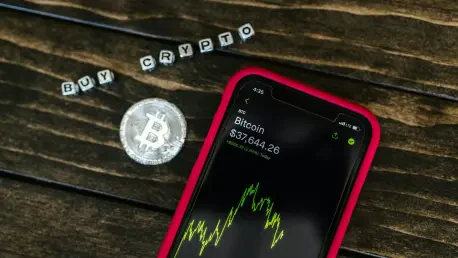Setting the Stage: A Cryptocurrency Milestone
In the ever-evolving world of financial markets, a staggering statistic has captured the attention of investors globally: BlackRock’s iShares Bitcoin Trust (IBIT) has recorded an unprecedented $3.5 billion in net inflows in just one week, positioning it ahead of traditional S&P 500 ETFs. This remarkable achievement signals a profound shift in institutional investment behavior and underscores cryptocurrency’s growing role in mainstream finance. This analysis aims to dissect the driving forces behind IBIT’s dominance, explore current market trends, and provide projections for the future of Bitcoin ETFs. The importance of understanding this phenomenon lies in its potential to redefine portfolio strategies and challenge long-standing investment norms. This examination offers a window into how digital assets are reshaping the financial landscape, inviting stakeholders to reconsider their approach to diversification.
Diving Deep: Trends and Data in the Bitcoin ETF Market
IBIT’s Unrivaled Performance Metrics
The spotlight shines brightly on BlackRock’s IBIT, which has not only surpassed S&P 500 ETFs like SPLG and VOO but also redefined benchmarks for asset accumulation. With $3.5 billion in net inflows over a single week, representing a substantial portion of total ETF flows, IBIT demonstrates an extraordinary investor appetite for Bitcoin exposure. Its assets under management (AUM) are nearing $100 billion, a milestone achieved in a fraction of the time taken by traditional equity funds. For context, while established S&P 500 ETFs took years to reach comparable AUM, IBIT’s rapid ascent highlights the accelerating momentum of cryptocurrency investments. Daily trading volumes hitting $5.7 billion further cement its market dominance, though concerns about volatility and regulatory oversight remain points of caution for potential investors.
Institutional Adoption Fuels Market Momentum
A broader trend underpinning IBIT’s success is the sweeping institutional embrace of spot Bitcoin ETFs. All 11 original funds in this category, including notable players like Grayscale’s GBTC, have reported consistent inflows during the same period, reflecting collective confidence in Bitcoin as a strategic asset. This synchronized growth stands in stark contrast to the slower institutional uptake seen in equity ETFs during similar market phases, underscoring the unique allure of digital currencies. The surge in demand suggests that large-scale investors view Bitcoin not as a speculative risk but as a vital component of diversified portfolios. However, the potential for sharp price corrections, especially with Bitcoin reaching record highs, poses a lingering challenge that could influence future adoption rates.
Regional Variations and Economic Drivers
Market dynamics for Bitcoin ETFs vary significantly across regions, shaped by regulatory environments and economic conditions. In the United States, a supportive framework has catalyzed rapid growth, enabling funds like IBIT to thrive. Conversely, stricter regulations in other global markets have tempered enthusiasm, creating disparities in adoption levels. Economic factors, such as concerns over currency devaluation, also play a critical role, with many investors turning to Bitcoin as a hedge against weakening fiat systems—a trend often referred to as the debasement trade. This multifaceted landscape reveals that while opportunities for expansion are abundant, navigating regional policies and economic uncertainties will be essential for sustained progress in the Bitcoin ETF sector.
Forecasting the Future: Projections for Bitcoin ETFs
Sustained Growth on the Horizon
Looking ahead, the outlook for Bitcoin ETFs appears robust, with market analysts anticipating continued inflows through the current year and beyond. Current data shows year-to-date inflows at $25.9 billion, with an additional $3.5 billion amassed in just the first few trading days of the latest quarter. Projections suggest that U.S. Bitcoin ETFs could surpass significant milestones in total inflows within the next couple of years, driven by growing investor interest and Bitcoin’s price performance, which recently touched an all-time high. Such forecasts indicate that these funds are not merely a passing trend but a transformative force in asset management, poised to rival traditional ETFs in scale and influence.
Technological and Regulatory Catalysts
Advancements in technology, particularly in secure custody solutions for digital assets, are expected to bolster confidence in Bitcoin ETFs. Enhanced platforms and infrastructure can mitigate risks associated with hacks or loss, making these funds more appealing to cautious investors. Additionally, potential regulatory clarity could further accelerate adoption by providing a stable framework for operations. As governments and financial bodies refine their stance on cryptocurrencies, the resulting certainty may attract even more institutional capital. These developments, combined with macroeconomic factors like inflation pressures, position Bitcoin ETFs as a compelling option for those seeking alternative stores of value.
Economic Trends Shaping Investment Strategies
Broader economic trends are also likely to shape the trajectory of Bitcoin ETFs. Persistent concerns about inflation and geopolitical instability drive interest in non-traditional assets, with Bitcoin often viewed as a modern equivalent to gold. The correlation between economic uncertainty and cryptocurrency investment suggests that as long as fiat currencies face devaluation risks, demand for Bitcoin exposure will remain strong. Market participants must also consider the interplay between Bitcoin’s price volatility and ETF inflows, as significant fluctuations could either spur or dampen investor enthusiasm. This complex interplay of economic indicators underscores the need for strategic planning in integrating digital assets into investment portfolios.
Reflecting on Insights: Strategic Steps Forward
Looking back, the meteoric rise of BlackRock’s IBIT, with its $3.5 billion weekly inflows and near-$100 billion AUM, marked a historic turning point in the financial markets. The widespread institutional adoption and robust market performance of spot Bitcoin ETFs signaled a fundamental shift in how digital assets were perceived and integrated into mainstream strategies. For investors and asset managers, the implications were clear: adapting to this new reality required proactive measures. Moving forward, stakeholders were encouraged to explore crypto-related products, leveraging regulated vehicles like ETFs to gain exposure while managing risks. Monitoring economic indicators such as currency stability and inflation trends became critical for timing investments effectively. Ultimately, the journey of Bitcoin ETFs highlighted an evolving landscape where staying ahead meant embracing innovation and recalibrating traditional approaches to wealth management.









